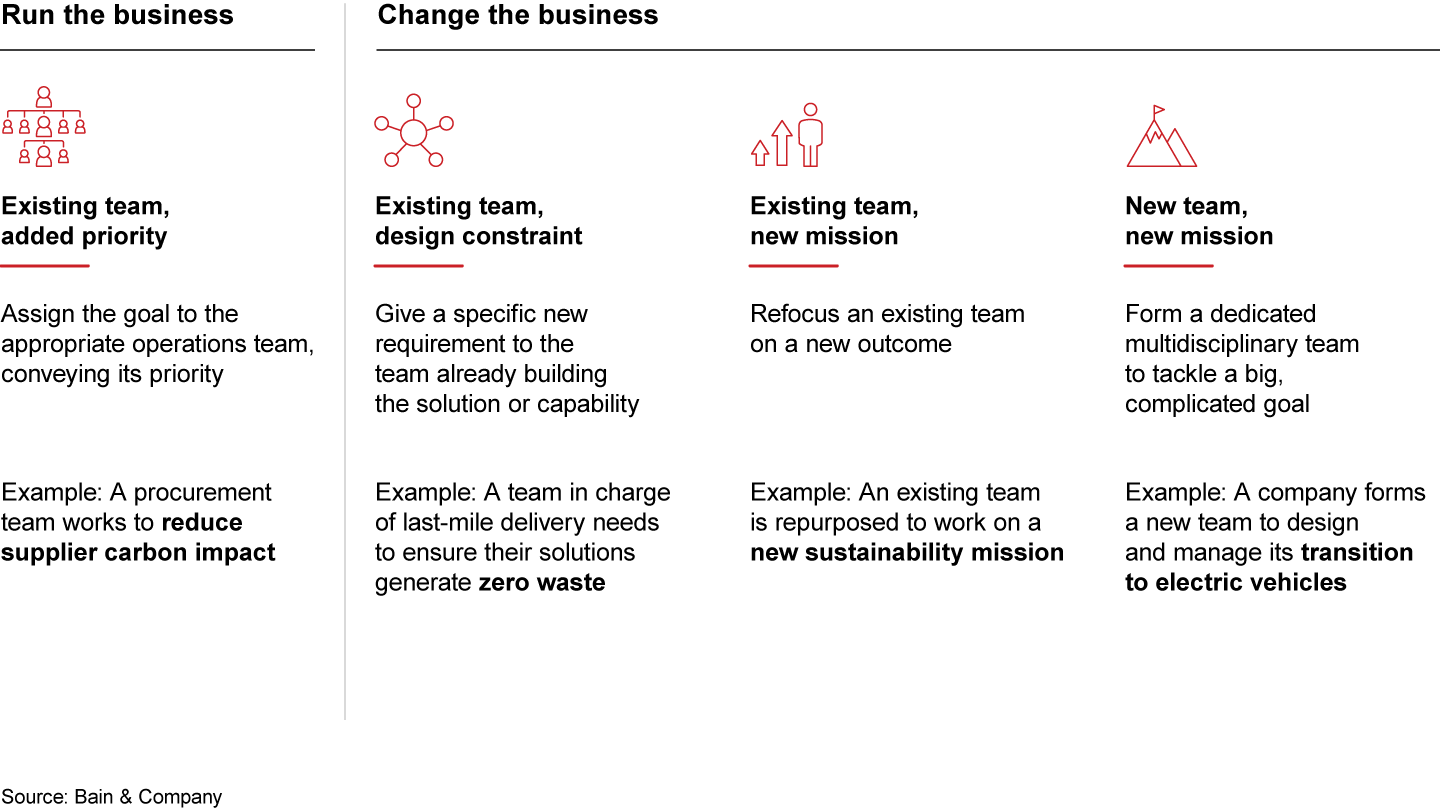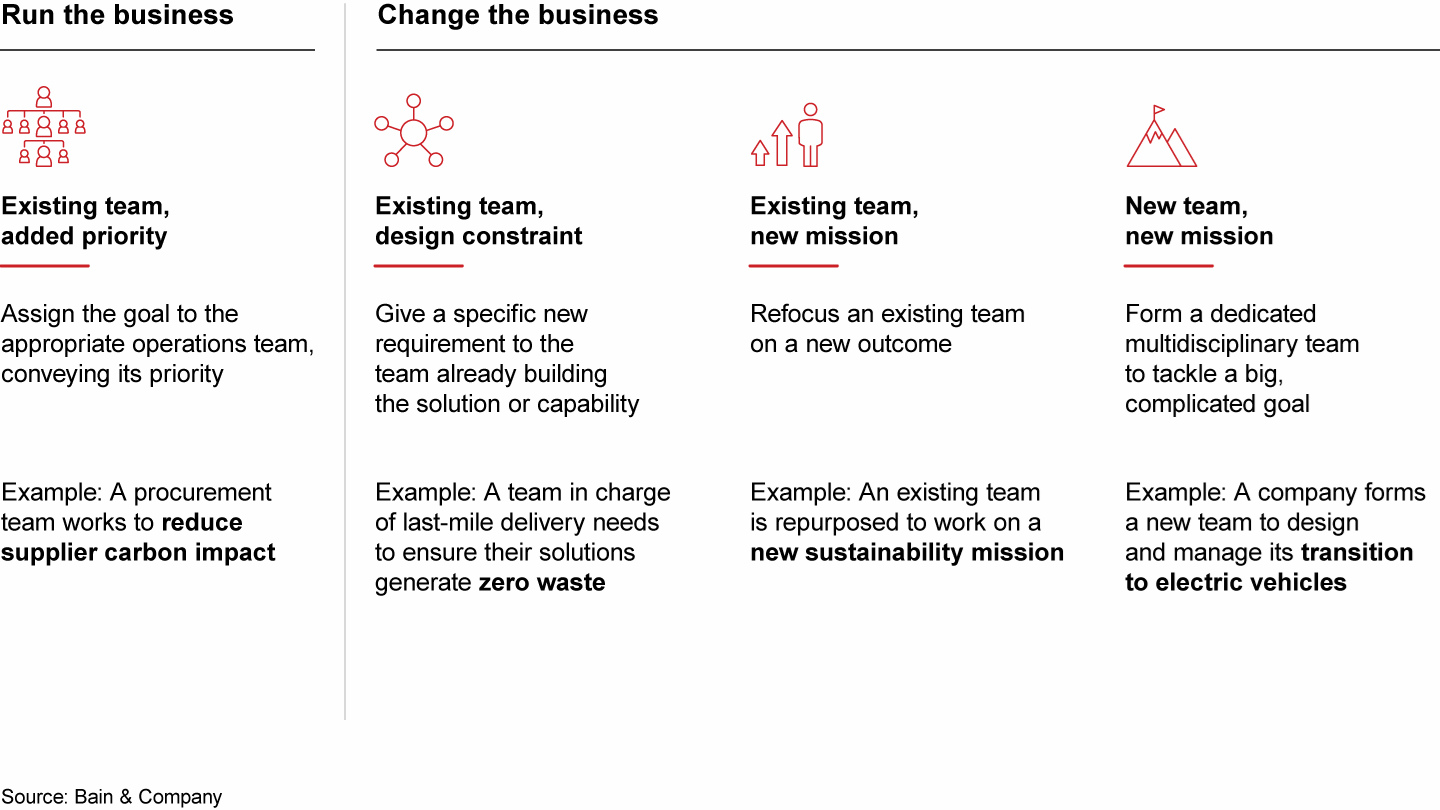The Visionary CEO’s Guide to Sustainability

At a Glance
- In a Bain survey, most executives report having a bold sustainability ambition with clear targets, but almost none feel they are on track to achieve them.
- Based on more than 300 conversations with executives and our work with scores of companies in transition, organizations that are succeeding at sustainability do four things consistently.
This article is part of Bain’s 2023 CEO Sustainability Guide
Companies have ambitious sustainability targets they are struggling to meet. In our recent global survey of large-company executives, 67% report having a bold sustainability ambition with clear targets across environmental, social, and governance aims, but only 3% feel they are on track to achieve them.
One consistent reason: Companies have not mobilized the core of their business to realize these sustainability ambitions. Instead, sustainability targets are set without input from the business units tasked with leading change. As a result, the businesses don’t feel they own the problem, leaving promising ideas withering from lack of support and slowing progress overall. A minority of leaders—fewer than 25%—believe sustainability is well integrated into their business today, our research found. It’s not surprising that 36% report being far below their expected level of progress on these issues.
With the right focus, however, companies can construct the operating model needed to advance a more sustainable future. This starts with embracing a new mindset. Today, many companies treat sustainability only as a constraint, something they have to do. They can’t expect to achieve their ambitions if they don’t see that sustainability is an opportunity to create value as well.
Based on more than 300 conversations with executives on this topic and our experience working with scores of companies in transition, organizations that are succeeding at sustainability do four things worth emulating.
1. Break down ambitions into a portfolio of business outcomes
Companies need to translate their sustainability ambitions into concrete, discrete goals mapped to specific business operations. This involves having challenging conversations and being open to setting multiyear goals, even when the solution or how it will be realized is not yet clear. Testing strategies to achieve these outcomes, and learning from those tests, is the only way to reach your true objective.
CEO Doug McMillon describes Walmart’s ambition as going “beyond sustainability to become a regenerative company dedicated to placing nature and humanity at the center of our business practices.” To get there, Walmart engages in challenging dialogues about business outcomes, considering the full implications of carbon reduction for refrigeration, for example, or what it means for the transport of goods to stores and in the last mile to customer homes, and what moving toward zero waste will mean for operations. The approach has helped Walmart reduce or avoid more than 750 million metric tons of emissions since 2017.
Chemicals and materials company Solvay has similarly focused its sustainability ambition on “climate, resources, and better life” and translated that into a roadmap of business outcomes. These include boosting energy efficiency and process electrification, increasing green power supplies across plants, reducing pressure on sites’ biodiversity, lowering water intake, and more. As a former global business unit president, the company’s chief sustainability officer, Pascal Chalvon Demersay, brings a business lens to sustainability. By systematically determining the environmental impact of all products and weaving sustainability goals throughout the organization, Solvay has reduced its direct emissions by 19% and its biodiversity pressure by 28% since 2018.
2. Seek out opportunities that benefit multiple stakeholders
It’s important that everyone working on new sustainability opportunities consider their broadest potential value to a variety of stakeholders.
A plethora of independent rating agencies now track the value companies generate for individual stakeholder groups and the complex relationships among them—data companies can use to design a strategy that delivers mutual benefits for all. (For more on this, see “Building a Data-Based Stakeholder Strategy.”)
In many situations, improving sustainability will require trade-offs among stakeholders. In the field of climate policy, frameworks and protocols that will help stakeholders share knowledge and analyze those trade-offs are being developed.
Efforts are most likely to benefit multiple stakeholders when that has been a goal from the start. Walmart’s sustainability team and business leaders regularly brainstorm how its efforts can help multiple stakeholders. When they thought about building electric vehicle infrastructure to reduce emissions in the transport of goods from stores and fulfillment centers to homes, they also considered the value that could bring to consumers, associates, and communities. In April, the retailer, which has storefronts within 10 miles of 90% of Americans, announced it would be building a low-cost EV fast-charging network at locations coast to coast, easing concerns about access to recharging and lowering transportation costs, while creating another opportunity for customers to shop—in this case, while recharging.
3. Dedicate teams to develop new solutions
While some sustainability activities can be delegated and cascaded directly to the leaders and teams already running the business, others require a more fundamental change to the business. For these, the traditional task force of people working part-time on a project basis is simply insufficient. Companies accelerating toward their sustainability ambitions dedicate teams to reimagine and then test potential new solutions.
Importantly, they match the team to the work. Depending on the type of goal, a new, dedicated multidisciplinary team might need to be launched, or it might be given to an existing team (see Figure 1). In either case, the team must be dedicated to the task in order to efficiently develop quality solutions.
Match the sustainability goal to the right team


4. Build a system to accelerate scaling good solutions
At any given time, Walmart has hundreds of tests running. Feedback loops provide near real-time identification of defects by associates and customers. Solutions that have been scaled and are being optimized are discussed in run-the-business operations meetings, while those in testing are discussed in biweekly transformation meetings. If teams need help between meetings, mechanisms exist to remove roadblocks and get them the resources they need to move as fast as possible. With sustainability outcomes built into the teams, sustainability goals benefit naturally from this well-tuned innovation engine.
The ability to scale their best new ideas, whether on sustainability or any other topic, is a hallmark of flexible organizations. This requires:
- A unit of scaling. This might be a store, a customer segment, a product, or a sales territory. It might be two units, five units, or the entire company.
- A defined release cycle. How often can customers, employees, suppliers, or other stakeholders expect to receive changes? Three times a year? Four?
- Feedback loops. When change is repeatable, good communication helps address defects rapidly.
- Transparent roadmaps. People want to know what might come next.
Impact
By adopting these practices, companies ensure that sustainability isn’t something being done on the side but is truly part of the business.
Solvay’s business leaders see sustainability as a way of mitigating risk and driving lasting value creation, so they build the business case for change on that basis. When they evaluate the business value of any effort, they do so with a carbon price of 100 euros per metric ton incorporated. They also screen for water use, waste valorization, and other ESG adjustments when considering all capital expenditures and M&A decisions. Performance on sustainability impacts 15% of the yearly bonus of all managers. This is all part of a growth strategy made possible by the company’s operating model, which includes four sustainable platforms: renewable materials and biotechnology, batteries, green hydrogen, and thermoplastic composites.
To understand how well their company is positioned today, CEOs can start by asking their teams a few high-gain questions:
- Do our middle managers own specific sustainability goals?
- Have we dedicated certain teams to sustainability innovation, to developing new solutions?
- Do our employees raise sustainability ideas that could become new sources of value?
- How could a repeatable model for scaling change accelerate our path to sustainability?